'Learn every day': The Rev. John Jenkins reflects on legacy of 19 years leading Notre Dame
- Oops!Something went wrong.Please try again later.
SOUTH BEND — When the University of Notre Dame’s Board of Trustees first announced the Rev. John I. Jenkins would become its 17th president 20 years ago, the 50-year-old philosopher from Omaha, Neb., began thinking.
Where could he take this prestigious university that it hadn’t been before? What would he do to advance an already sterling reputation in higher education? How could he continue to inspire the global excellence in which Notre Dame long ago planted its flag?
His new journey, challenge if you will, started with a speech.
“I spent a lot of time thinking and focusing on my inaugural address that I was to give in the fall of 2005,” Jenkins said last month during a wide-ranging interview with the South Bend Tribune. “That helped me figure out what is important and what is our broad vision.”
▶ COMING FRIDAY: How Notre Dame, South Bend and Indiana are working together like never before
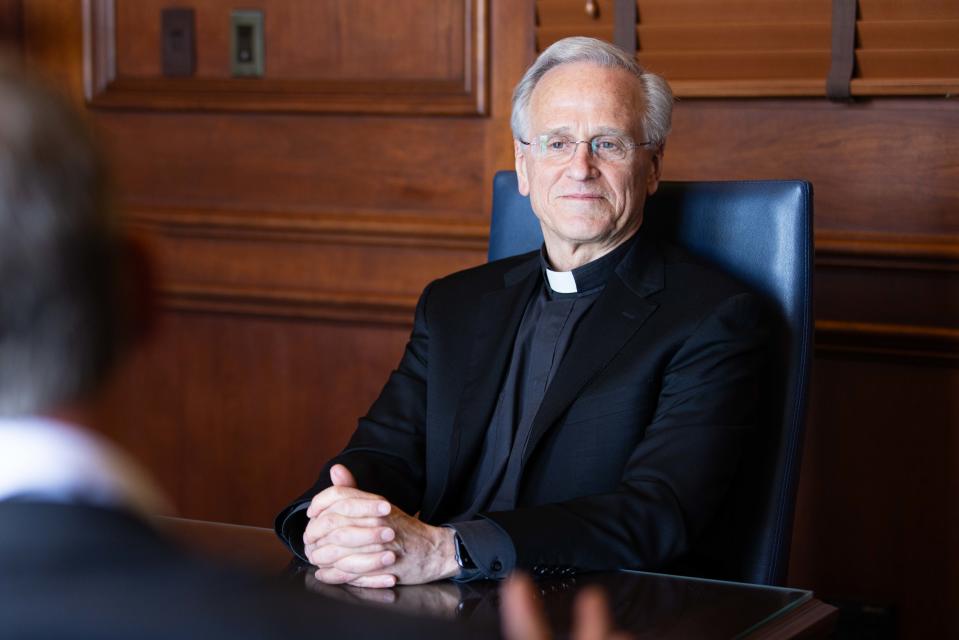
Jenkins, now 70, who over the past 19 years led Notre Dame to unprecedented financial health while simultaneously bolstering its world-class academic profile through a commitment to research, will retire effective June 1.
The Rev. Robert A. Dowd will take his place in the president’s office under the Main Building’s Golden Dome.
One of Jenkins' last acts as university president since succeeding the Rev. Edward A. “Monk” Malloy will be to give Sunday’s keynote commencement address to the Class of 2024.
The ceremony at Notre Dame Stadium begins at 9:30 a.m.
More: Rev. Robert A. Dowd to replace Jenkins in July as president of University of Notre Dame
Jenkins’ influence on arguably one of the most prosperous and transformative eras in Notre Dame’s 180-year history is undeniable.
In two decades as the leader of America’s preeminent Catholic university, Jenkins helped change the face of campus with vast facility upgrades, spearheaded financial growth that pushed Notre Dame’s endowment beyond $20 billion and dialed in a focus on research expansion that now stands among the nation’s most elite schools.
It’s clear Jenkins leaves the university stronger than it was before his presidency. Now, he says, after Notre Dame completed its strategic framework, it’s time for someone else to take the reins.
“I did think the university needed a leader who had a five- or 10-year horizon rather than a one- to two-year horizon,” Jenkins said of the timing of his exit. “I wasn’t going to do five to 10 years. So, it just seemed the right time for me and the right time for the university."
Father Jenkins' journey to Notre Dame
Raised in the heart of the Midwest, the third oldest of 12 children, Jenkins first arrived at Notre Dame as a student in the fall of 1973. He was the son of a gastroenterologist and had completed his freshman year at Crieghton University, where his father was on faculty.
Inspired by a back-packing adventure through Europe before his sophomore year — in which he visited Notre Dame Cathedral in Paris, the Dachau concentration camp in Germany and Saint Peter’s Basilica in Rome — Jenkins decided to transfer to Notre Dame, where his oldest brother already attended.
“I don’t know if I had anything as auspicious as aspirations when I came here at 18,” said Jenkins, who was drawn by Notre Dame’s growing academic reputation and Catholic mission. “It seemed like a great place, an exciting place. That’s why I chose it.”
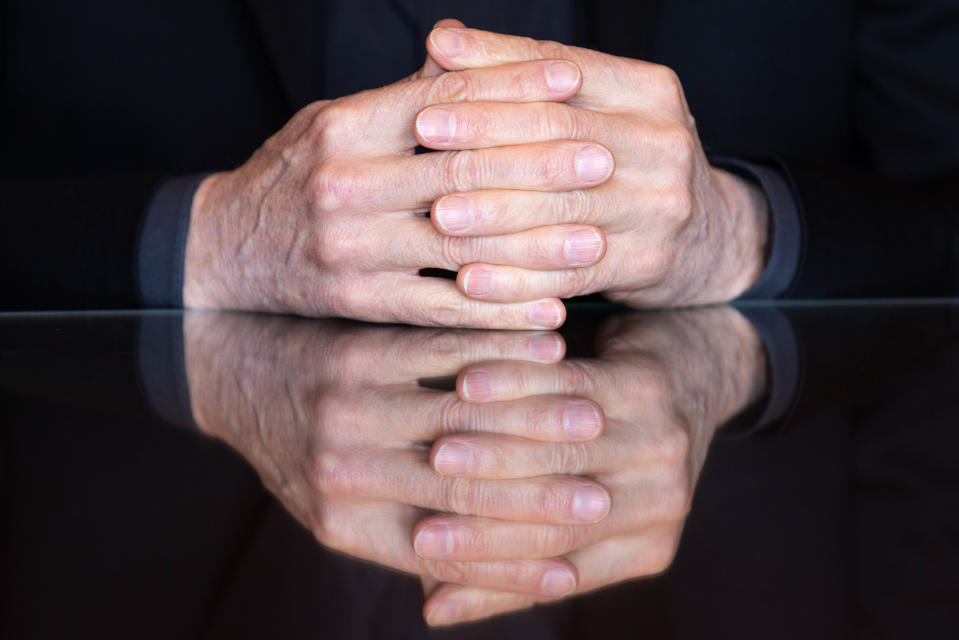
Jenkins lived in Flanner Hall and studied philosophy, not knowing where exactly it would lead.
The thought of becoming a priest had not occurred to him, let alone the idea of one day shepherding the great university that was at the time under the direction of the legendary and transcendent Rev. Theodore M. Hesburgh.
"I was very interested in learning and inquiry,” Jenkins remembered. “I hoped that I would learn and explore ideas and thoughts. That’s probably as defined as it was at the time … not very defined.”
He graduated in 1976 with a Bachelor of Arts degree in philosophy and completed his master’s at Notre Dame two years later. By that time, the priesthood was calling.
“It was partly my time here and reflecting on my life and what I wanted to do that led me to this path,” he said. “I really didn’t decide anything until after I graduated in 1976. But then my thoughts coalesced, and this seemed like the right choice.”
He was ordained as a Holy Cross priest in 1983 before earning doctoral degrees in philosophy from Oxford University (1987 and 1989) and a Master of Divinity and Licentiate in sacred theology at the Jesuit School of Theology at Berkeley, California (1988).
In 1990, Jenkins joined the philosophy department at Notre Dame. He’d later serve as a vice president and associate provost under Nathan Hatch, who in 2005 became president of Wake Forest University.
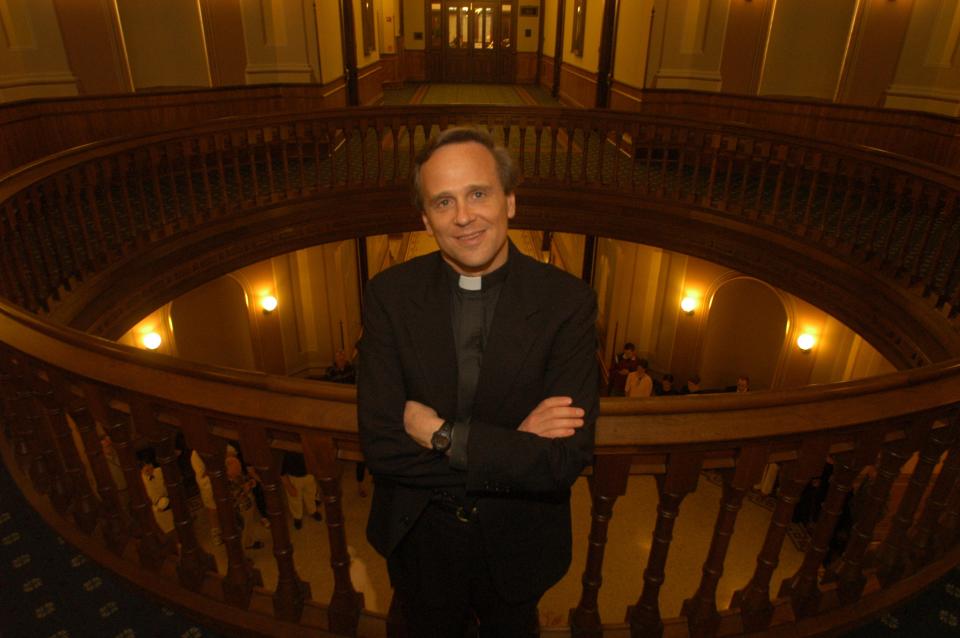
Becoming the University of Notre Dame's 17th president
In the spring of 2004, Malloy announced he was retiring following the academic year. He had served in that office since Hesburgh’s retirement in 1987 and planted many of the seeds that Jenkins fostered to maturity under his watch.
By that time, the soft-spoken and cerebral Jenkins had been sufficiently groomed to ascend to the presidency, which Notre Dame’s bylaws require be a Holy Cross priest.
“So, it’s not a big pool,” Jenkins wryly joked. “The board of trustees makes the decision. You’ll have to ask them how they arrived at it. I just responded as well as I could and took the role when I was asked. The rest is history.”
And it’s quite a history.
Since taking over, the university has undergone a construction boom both on and around campus worth billions. That includes the over $400 million Campus Crossroads project completed in 2018 that modernized Notre Dame Stadium by integrating it into the university’s academic and student lifestyle mission.
That includes the Stinson-Remick Hall of Engineering (2009), the Irish Athletic Center (2019) the Compton Family Ice Center (2011) and a major renovation of the Joyce Center (Purcell Pavilion).
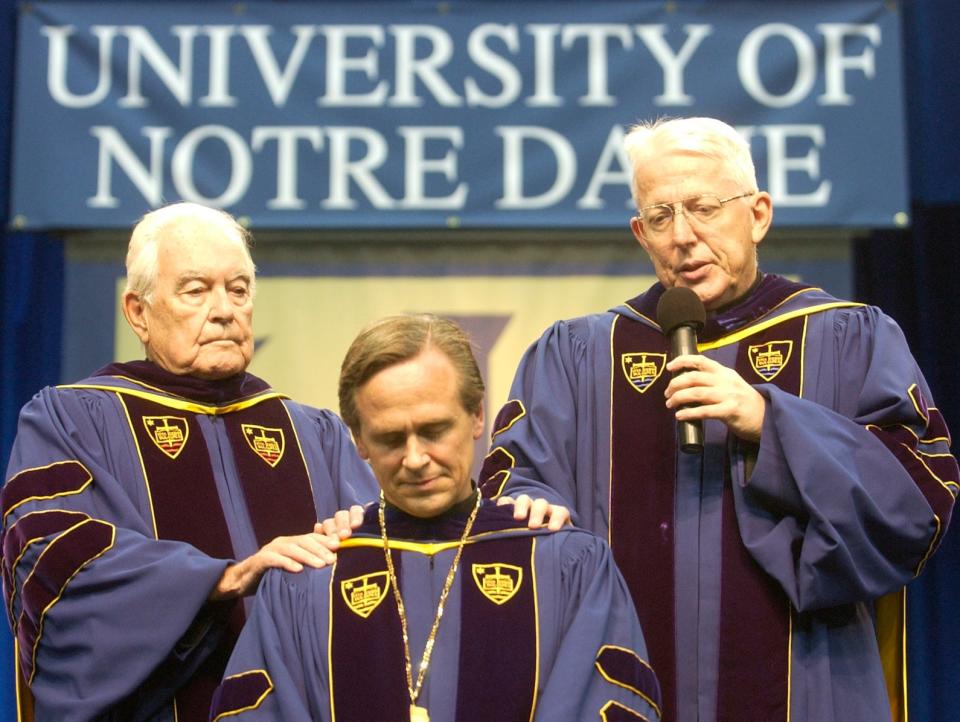
That also includes the Walsh Family Hall of Architecture (2019), Irish Green (2009) and the Raclin Murphy Museum of Art (2023).
And flowing just beyond the southern border of campus across Angela Boulevard, that includes Innovation Park, Eddy Street Commons and countless high-end housing infill down Notre Dame Avenue, the Northeast neighborhood and the blocks surrounding it.
“It was very important,” Jenkins said of the facility upgrade plan. “A lot of those buildings have allowed us to improve on research and other things that are important.”
Such as livability on and around campus, as well as a stronger and more natural connection with the South Bend community.
“We think of that area by Angela as the front yard of the university where we connect with the community,” Jenkins said. “There’s the DeBartalo Performing Arts Center, which is a wonderful venue for live performances, theater and movies. The Raclin now is for fine arts, visual arts. Both are great for campus and a connection to the community and the cultural richness of this area."
South Bend Mayor James Mueller, himself a Notre Dame graduate, knows the history between the university and the city and the stretches of isolation between the two.
Therefore, he knows how far the working relationship has come.
“The city was world-famed and the place to be before Studebaker closed (in 1963)," Mueller explained. "Under Father Hesburgh, Notre Dame rose to international fame, but for the most part, the city and the university were doing their own thing. It was Father Malloy who began in the late 1980s to start rebuilding connections with the city.
“Father Jenkins took it to the next level.”
Becoming a leading research university
Since Day 1 of his presidency, Jenkins’ top objectives have been establishing Notre Dame as a top research university in the country, increasing undergraduate financial aid to strengthen socioeconomic diversity and attracting more international students.
The first initiative he mentioned during his inaugural address was that Notre Dame “enthusiastically embrace” its potential as a major research university.
To Jenkins, it was the next obvious step.
“Notre Dame made its name as a great undergraduate university,” he said. “For a long time, it’s been recognized as an excellent place for undergraduates to come and learn and grow as people. That was our crown jewel. That was our strength.
“Our opportunity for growth was, and is, as a research university. That’s hard to do. It’s hard to build the resources for that, it’s hard to find the faculty that can help you lead in that way. So, it’s a long-term effort.”
One that dates back to Hesburgh's tenure, and Malloy’s. Under Jenkins, Notre Dame took that momentum and hit the gas. It’s now the only religiously affiliated member of the prestigious Association of American Universities (AAU), which consists of 71 of the nation’s top research schools.
Indiana Gov. Eric Holcomb marvels at what Jenkins and his team have been able to accomplish in research in such a short time. That research has become critical, Holcomb said, to Indiana's overall growth strategy, especially in trying to attract federal hubs to the state and emerging as a leader in artificial technology.
“It all starts with research," Holcomb told The Tribune this week. "Father Jenkins looked out over the horizon and asked, 'How do we become not just a global player, but leader at the beginning of the spectrum?' That’s the research before the creation.
“It’s incredible how fast and far Notre Dame has come with its commitment on the research front. The state relies on — to be blunt — Notre Dame’s advancements."
According to Notre Dame’s 2033 Strategic Framework, the university raised $78 million in external research funding in 2004. In 2022, that annual figure reached $281 million.
More: When Notre Dame president Rev. John Jenkins steps down, legacy of research will remain
Innovation Park and the subsequent IDEA Center stand as the centerpieces of Notre Dame’s proliferation as a research power while tethering it even more to community benefit.
“The IDEA Center and Innovation Park are about moving the ideas and discoveries of faculty to practical applications in businesses,” Jenkins said. “Unless you’re strong in research, you can’t have that impact. We’ve come to a point where we are strong enough that we can be helpful to the region. Things like the IDEA Center are the translation of ideas into practical effects.
“That’s why it’s an opportunity both for us here at Notre Dame and the community to take advantage of this innovation and make this region ever more vital, economically strong and prosperous.”
Leading the university family through tragedy
Although Notre Dame’s future has brightened under Jenkins’ leadership, there were still dark days to navigate.
On the turbulent fall afternoon of Oct. 27, 2010, Notre Dame junior Declan Sullivan, a videographer for then first-year head coach Brian Kelly’s football program, was recording an outdoor practice from atop a 40-foot lift positioned along Courtney Lane.
Wind gusts blasted past 50 miles per hour, one of which toppled Sullivan’s lift, killing the 20-year-old Chicago native in front of players, coaches and classmates.
Shortly before the tragedy, Sullivan tweeted about the conditions: “This is terrifying. I guess I’ve lived long enough.”
There was profound sadness, but also outrage that Sullivan was sent up in the gale.
Jenkins alluded that it was the most difficult and trying moment of his 19-year tenure.
“Nothing,” Jenkins said, “is harder than losing a student.”
Shortly after the incident, Jenkins told the broader Notre Dame community in a letter that “Declan Sullivan was entrusted to our care, and we failed to keep him safe.”
While Kelly, athletic director Jack Swarbrick and Jenkins were adamantly criticized by the general public, the Sullivan family refrained. Instead, they put their energy into creating a foundation that serves under-resourced children in Chicago.
Jenkins said he is inspired by how the Sullivans transformed Declan’s memory into hope for others.
“It’s such a wonderfully positive story,” the priest said of the Declan Drumm Sullivan Memorial Fund. “It’s going through darkness to make sense of the whole thing. … The Sullivans have become friends.”
Dealing with Obama and 'Rose Garden' controversy
As had become custom at Notre Dame, Jenkins invited freshly sworn-in U.S. President Barack Obama to deliver the 2009 commencement address.
He became the eighth sitting president to address Notre Dame students on campus. Others include Franklin D. Roosevelt (1935), Dwight Eisenhower (1960), Gerald Ford (1975), Jimmy Carter (1977), Ronald Reagan (1981, just two months after he was shot in an assassination attempt, and 1988), George H.W. Bush (1992), and George W. Bush (2001 and 2005).
Then-Rep. John F. Kennedy, who would go on to become the nation’s first Catholic president, delivered the winter commencement address in 1950. Then-Vice President Joe Biden, along with former Speaker of the House John Boehner, both spoke at Notre Dame when they were awarded The Laetare Medal by Jenkins in 2016.
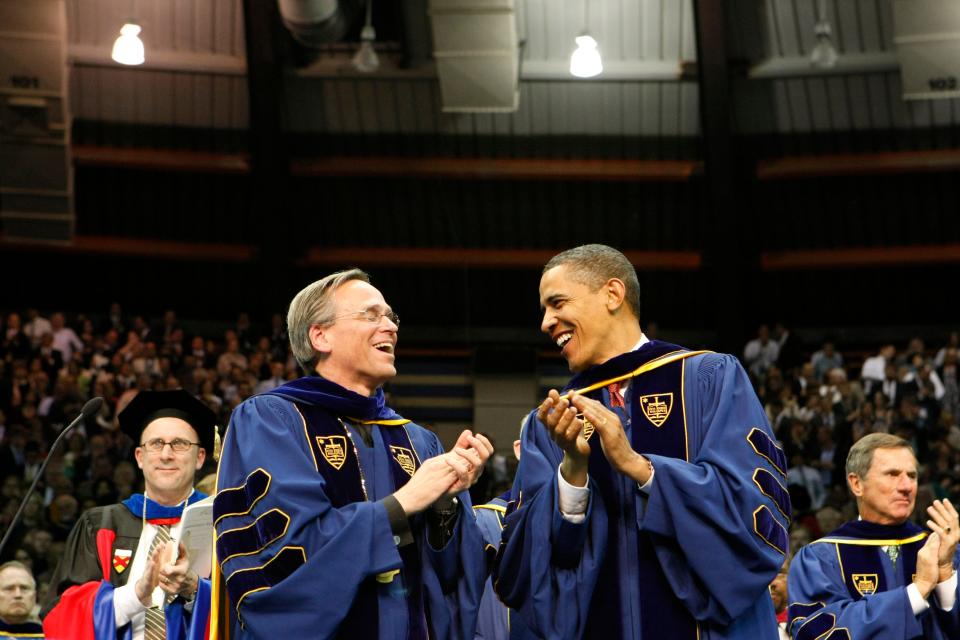
Obama’s pro-choice stance on abortion — contrary to Catholic teaching — immediately sparked a firestorm of criticism that stills bubbles to the surface yet today.
Undeterred, Jenkins saw the invitation through.
“I hope we’re a place where people can come to speak,” Jenkins said, “even if we disagree.”
After Donald Trump was elected president in 2016, Jenkins invited Vice President Mike Pence, a former Indiana congressman and governor, to speak at commencement. As with Obama, Pence’s address was met with some protest in a polarized political climate.
“If I’m proud of anything,” Jenkins insisted, "it’s we’re able to have a range of voices and still listen to people and say what you think. That’s what a university is about.”
Obama remains the last sitting president to speak on campus.
In 2020, Notre Dame was to host the first presidential debate — Jenkins is on the board of directors for the Commission of Presidential Debates. The university, however, withdrew as a host site with the COVID-19 pandemic raging.
Perhaps the most “embarrassing” moment of Jenkins’ time as president came in September 2020, when Trump announced the Supreme Court nomination of Notre Dame law professor Amy Coney Barrett during a Rose Garden ceremony at the White House.
Unmasked during the event, Jenkins was one of over a dozen attendees to contract COVID, including Trump.
Jenkins recovered but was prompted to write an apology to students, faculty and staff.
"It was a bad decision by me," Jenkins told the National Catholic Reporter. "… It was dumb and I shouldn't have done it."
'Do something great'
For Jenkins, who took office when he was 51, there are still far more recognitions and achievements than regrets.
He piloted an already soaring university into even more rarified air within global academia.
Through long-term financial planning and investment, Notre Dame’s endowment has grown from around $4 billion in 2005 to over $20 billion, among the most valuable in higher education.
“If you don’t have the financial basis,” Jenkins said, “you can’t achieve the aspirations you want to achieve — whether its financial aid or research or anything else.”
And Notre Dame’s athletic programs flourished, winning 10 national championships under Jenkins’ and Swarbrick’s leadership. The duo also helped direct the historically proud football program back to national prominence, while maintaining its independence.
The accomplishments are simply too many to list.
“It’s a very demanding job, so your heart better be in it,” Jenkins said. “There are two things to this job: There’s the big vision and then there’s the day-to-day. I had a lot to learn about the day-to-day. I told myself to each day come in more knowledgeable than I was the day before.
“Learn every day.”
When French priest Father Edward Sorin founded Notre Dame in 1842 after a long and harsh journey north, he proclaimed, "This college will be one of the most powerful means of doing good in this country."
Holcomb, who is finishing the final year of his second term as governor, calls Jenkins "an international powerhouse," who is "living out Father Sorin's charge."
When Holcomb was first elected governor eight years ago, one of the first calls he received was from Jenkins.
"He may not remember it, but I sure do," Holcomb said. "… Father John is a true North Star in terms of civil conduct in civic duty. That’s a pretty powerful one-two punch."
Jenkins plans to stay at Notre Dame and teach again and write. He also wants to remain a resource for Dowd, much the way Malloy and Hesburgh, who died in 2015, were for him.
“They alone knew what the job involved,” Jenkins said of his predecessors. “They knew its pressures and difficulties. To have someone to talk to who understood that was a great benefit.
“I hope I can do for my successor what Father Malloy and Father Hesburgh did for me.”
So, what will he miss most about being president at Notre Dame?
“You’re in the middle of really important conversations,” Jenkins said. “That’s all great, and I’ll miss that. But what I’ll miss most is the team I work with. I’m blessed to have talented, smart, dedicated people. Our success is the fact that people came together to do something great.”
Michael Wanbaugh is an editor at the South Bend Tribune. Email at mwanbaugh@sbtinfo.com or follow on Twitter @MWanbaugh.
This article originally appeared on South Bend Tribune: The Rev. John I. Jenkins reflects on 19 years as Notre Dame's president

